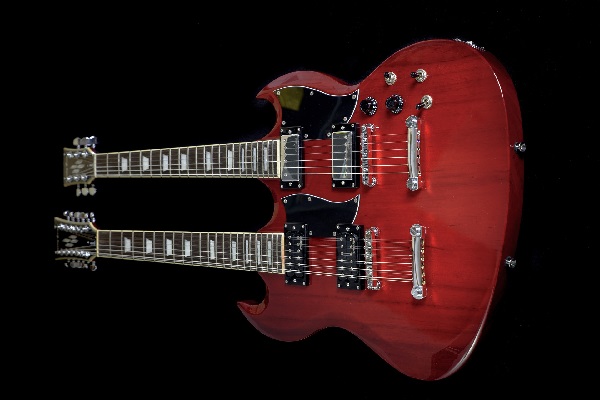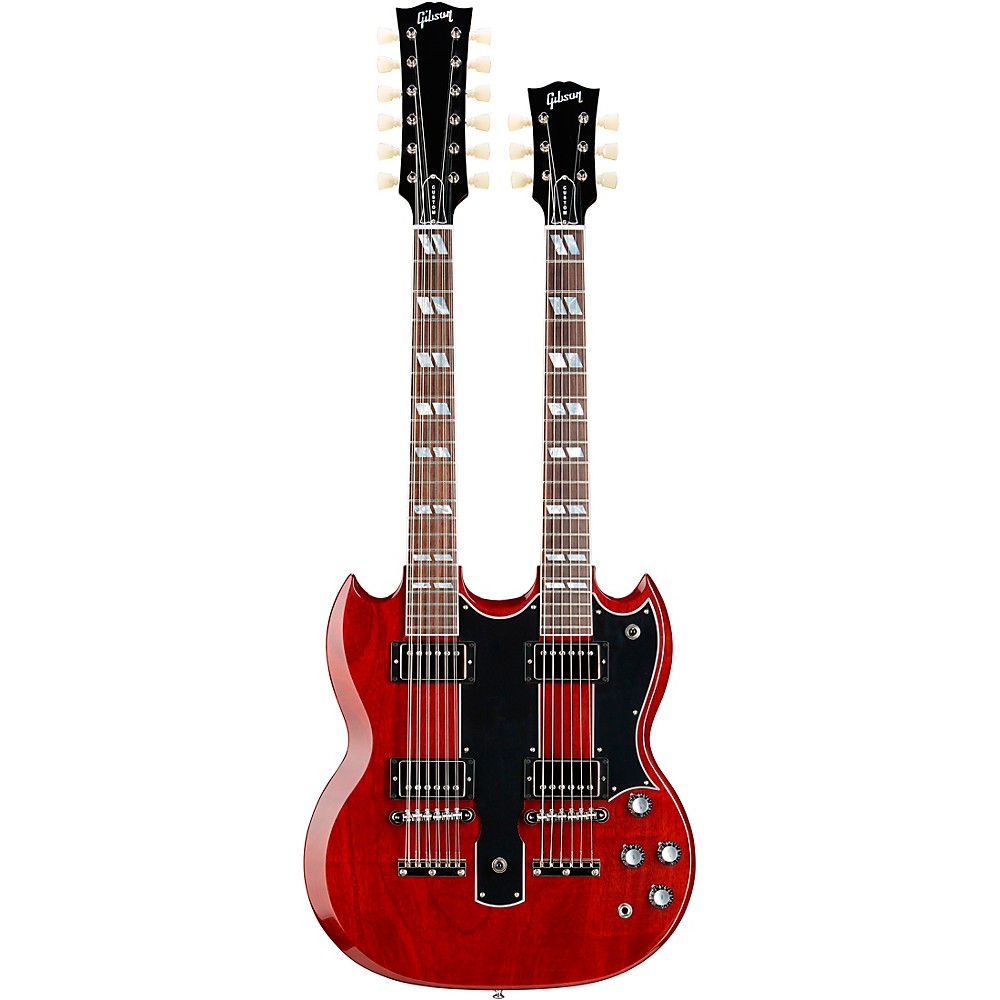Have you ever seen a guitarist on stage wielding a guitar with two necks and wondered – what is that thing? That, my friend, is the iconic double neck guitar.
With its dual necks and double the strings, it allows guitarists to easily switch between two distinct tunings and tones mid-song.
The double neck guitar has a long and storied history dating back centuries, though it really came into the mainstream in the 1960s and 70s through players like Jimmy Page of Led Zeppelin. Today, boutique luthiers are keeping the mystique of the double neck alive through hand-crafted custom models.
In this guide, we’ll explore the origins, designs, famous models, playing techniques and modern revival of the double neck guitar. Get ready for a deep dive into one of music’s most beloved mutant instruments!
History and Early Origins
Believe it or not, double neck guitars have existed in some form since at least the 1690s. The earliest known example is a small guitar with an even smaller ukulele-like neck grafted onto the treble side, built around 1690 in the style of French luthier Alexandre Voboam.
This was likely made for a professional musician who needed to transpose keys quickly in ensemble playing. Throughout the 18th and 19th centuries, double neck guitars appeared sporadically but never saw large scale production. Most examples from this era were custom one-off pieces.
That changed in the 1890s as modern manufacturing methods enabled the mass production of instruments. With more double neck guitars being built, demand grew steadily.
The models of the late 1800s catered to the tastes and styles of the times – namely harp guitars, lute guitars, and mandolin guitars. Each had different approaches to playing the extra neck, whether drones, alternate playing, or used for transposing.
While not immensely popular, these unusual instruments laid the groundwork and established the viability of the multi-neck concept.
Key Innovations and Pioneering Builders

The rise of lap steel guitars in the 1910s and the popularity of Hawaiian music brought new attention to the potential of double necks. Steel guitar legend Alvino Rey claims to be one of the first players to use a double neck lap steel, commissioning a model from Gibson in the mid 1930s.
As electric Spanish guitars took over, the lap steel receded from view. But a visionary guitarist named Jimmy Bryant recognized the potential of a double-neck Spanish guitar.
He enlisted the Stratosphere Guitar Manufacturing Co. of Missouri to create the Stratosphere Twin in 1954 – considered the first production model double neck electric guitar.
This guitar sported one 6-string neck and one unique 12-string neck tuned in thirds. Though it never caught on widely, the Stratosphere Twin helped set the stage for what came next.
In many ways, the 1950s luthier Semie Moseley was the pioneer who popularized double neck Spanish guitars.
After learning his craft from the great Paul Bigsby, Moseley opened his own shop in 1954 and began producing double necks for players like Joe Maphis and Larry Collins. His precision work and knack for innovation set new standards in double neck design.
Major guitar companies took notice of Moseley’s success. In 1958, Gibson debuted the double neck EDS-1275 with two 6-string necks and the EMS-1235 Double Mandolin with a mandolin and guitar neck.
Initially offered as thinline hollow models, by 1962 they transitioned into the sleek, iconic SG-style bodies. Fender’s Southern California rival Carvin also offered dual neck models starting in 1959.
With big names like Gibson and Carvin now producing double necks, the instrument gained greater visibility and credibility.
Still, it took the ascendance of Led Zeppelin and the theatrics of guitarist Jimmy Page for the double neck guitar to truly penetrate the mainstream. Page’s use of the Gibson EDS-1275 on epic tracks like “Stairway to Heaven” cemented its status as an iconic rock and roll mainstay.
Design and Construction
So what exactly goes into crafting these mutant multi-necked axes? Here’s a quick overview of some key design elements:
Scale Lengths: The scale length – the vibrating string length between the nut and bridge – determines the overall neck size and tension feel. Shorter scales have slinkier tension while longer scales have tighter tension and brighter tone. Common scales are 24.75″ for guitar and 34″ for bass.
Neck Shape: Thicker, rounded 50s-style necks offer more lower mids while thin, flat modern necks provide a tight feel and brighter tone. Neck shape impacts playability and sound.
Fretboard: Rosewood and ebony fretboards are common for warmth and clarity. Maple offers a bright snap and visual appeal. Some use exotic woods for unique looks.
Body Style: Carved single cutaway or sleek double cutaway shapes allow easy upper fret access. Weight-relieved chambers or solid cores change resonance.
Woods: Mahogany and maple are typical body woods for a balanced tone. Heavier woods like walnut or lighter like ash/alder alter the sonic character.
Hardware: Robust bridges, tailpieces, tuners and controls are essential for reliability and performance.
Electronics: Pickups, wiring, pots and switches enable sonic versatility. More controls = more sounds.
Luthiers carefully consider all these factors (and more) to craft a comfortable, great sounding, and visually striking dual neck guitar.
Notable Production Models
While custom shops offer one-of-a-kind builds, a number of major manufacturers have produced iconic double neck models that withstand the test of time:

Gibson EDS-1275: First released in 1958, the EDS-1275 Double 12 remains Gibson’s flagship doubleneck. With a 12-string and 6-string neck, it gained fame under Jimmy Page then later Steve Miller. Still in production today, it’s a staple of the Gibson lineup.
Gibson EMS-1235: Also introduced in ’58, the EMS-1235 Double Mandolin combines a 12-string guitar neck with a shorter scale octave mandolin neck for a distinctive hybrid sound. This historic model saw lower production numbers than the 1275.
Carvin #1-MS: Part of Carvin’s debut 1959 lineup, the #1-MS paired a 6-string guitar neck with a short scale mandolin neck. Along with the #4-BS bass/guitar model, Carvin offered the 1-MS well into the late 1960s.
Gretsch 6025: The wild 1961 Gretsch Bikini model lets players mix and match guitar, bass and guitar/bass double neck sections via a hinged “butterfly” body. Too radical for the time, few were made but they exemplify Gretsch’s innovation.
Playing Technique and Usage
So what do players actually do with these complex double neck instruments? Here are some of the most common techniques and uses:
- Harmonizing melodic lines between the two necks
- Instant alternate tunings for more variety
- Lower bass register paired with midrange guitar tones
- “Stairway to Heaven” style guitar 12-string intro to 6-string solo moments
- Unlocking brighter acoustic tones on a 12-string neck
- New tones and textures blending the disparate voices
- Fretboard gymnastics and neck tapping tricks
- Omnipresent power of the Rickenwrecker 360/12 Electro!
In the right hands, these hyphenated guitars enable sounds unattainable on their single neck brethren.
Modern Revival and Boutique Builders
You might expect the complex double neck guitar to fade into obscurity as a mere vintage curiosity. But thanks to small scale luthiers and custom shops, the instrument continues to evolve.
Modern designers like Rick Nielsen of Cheap Trick developed new variations in partnership with Hamer Guitars in the late 1970s and 80s. The popularity of heavy metal and hard rock in the 80s encouraged shredders to push the limits of excess – including dual neck extravagance.
While the trend came and went, top builders took notice of elite players hungry for custom double necks.
Today companies like Gibson Custom Shop, ESP Custom Shop and Jackson Custom Shop offer made-to-order double necks with premium tonewoods, exotic inlays and boutique craftsmanship.
Turnaround times of 6 months to a year are typical – while prices range from $5,000 to $10,000+. At this lofty level, each instrument is a unique work of functional art.
Advanced digital modeling technology also enables even more radical designs. With options like integrated acoustic/electric models, the future looks bright for multi-necked mutant guitars!
Final Words
We’ve come a long way from those earliest multi-neck guitars cobbled together centuries ago. Thanks to pioneering builders, innovative manufacturers and dedicated players, the double neck guitar has carved out a niche as one of music’s most iconic instruments.
Its form echoes its function – enabling guitarists to expand their creative range. Unwieldy? Sure. Excessive? Perhaps. But for those who can tame them, double neck guitars unlock tones and techniques inaccessible on any other instrument.
If you get the chance to try one, embrace the weirdness and see where the twin necks take you! Your bandmates and audiences won’t know what hit them. Any guitarist up for the challenge will surely fall for the allure of the double-necked mutant magic.
About the Author
Team Guitar Top Review Talk about Guitars! We are a group of friends that bonded over their shared love of playing guitar. We all have different backgrounds and experiences with music, but we share a passion for writing about the things that we love.



